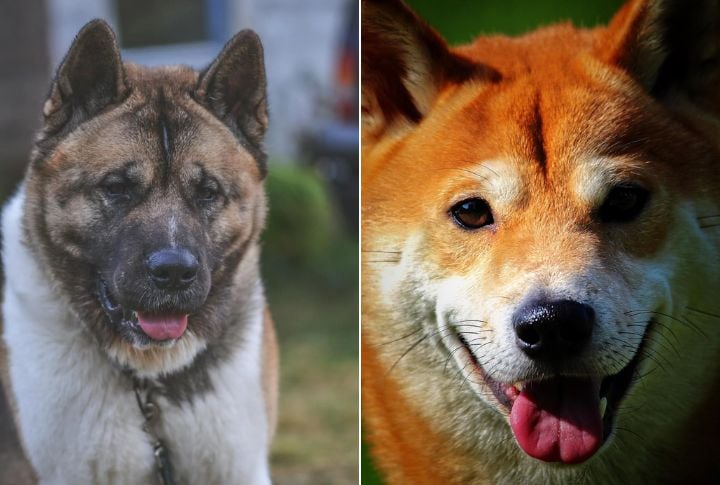15 Key Contrasts Between Akita Inu and Shiba Inu That Every Dog Owner Should Understand

Two iconic Japanese breeds, yet two entirely different canine experiences. One radiates confidence with its protective instincts, while the other charms with its fiery independence. The decision to choose between these two dogs extends beyond size differences alone. Before you decide, here are 15 important distinctions to note.
Size

Physically, the Akita Inu is muscular and tall, built for endurance. On the other hand, the Shiba Inu is compact and agile, with a build that facilitates quick, nimble movements. These differences translate to unique exercise requirements and adaptability levels, as size plays a significant role in determining their capabilities in different environments.
Personality

A dog’s personality influences daily interactions and trust development. The Akita Inu’s calm yet protective nature is respected. With its fearless and independent spirit, the Shiba Inu forges its own path, which reflects its distinctive interaction style. Understanding these temperaments is vital for proper training techniques.
Origins

Japan has long revered the Akita for guarding and hunting large prey. Shiba Inu earned its place hunting small game with remarkable precision. A closer look at the breeding histories provides intriguing perspectives on their unique attributes and reveals how their original functions influenced their development.
Coat Type

Dense double coats characterize both canines but vary in maintenance levels. Akitas demand regular brushing to manage their heavy seasonal shedding. However, Shiba Inus require moderate grooming to maintain their naturally sleek and shiny coats. Proper coat maintenance ensures a healthy life for both in different climates.
Training

Dogs don’t come with an instruction manual, but training makes life smoother. The Akita Inu prefers firm leadership, so making clear boundaries is essential. Think of the Shiba as the mischievous genius—smart but undeniably headstrong. Tailoring training to each breed’s personality improves obedience and strengthens the bond between owners and their dogs.
Activity Levels

To ensure a happy and healthy life, the Akita, also known as the Great Japanese dog, needs a lifestyle that matches its energy level. Regular, low-impact activities that respect their gentle, methodical pace are paramount. Shiba Inus prefer high-energy routines, as they thrive on frequent engagement.
Social Behavior

Dogs have their own social rules, and these two breeds prove it. With a strong instinct to protect, Akita Inus are wary of strangers. Shiba Inus, though affectionate, maintain control over their interactions and interact only when it suits them.
Common Health Concerns

Healthwise, Akitas are vulnerable to conditions like hip dysplasia and immune system disorders. Known as the Little Brushwood dog, the Shiba Inu is more susceptible to issues such as patellar luxation and allergies. Health issues can be detected early with proactive care, which can significantly improve a dog’s quality of life.
Suitability For Families

The ideal breed for a household depends on various factors. Akita Inus require ample space and experienced owners who can provide proper socialization. Shibas can thrive in apartment settings, provided they receive active engagement and mental stimulation. This highlights the importance of matching the dog’s characteristics with living situations.
Lifespan

Dogs don’t live forever, but knowing their lifespan helps prepare for the journey. Both are known for their longevity, with Akita Inus typically living up to 14 years when taken care of. Shiba Inus usually make it to 16 years old. Although not significant, this difference counts.
Vocalization

The Akita Inu expresses itself with deep, measured vocalizations, often signaling authority. In contrast, Shibas are famous for their “Shiba scream,” a dramatic vocal response. Each dog’s vocal style plays a vital role in how they convey emotions and interact with their surroundings.
Dietary Preferences

Nutritional balance plays an important role in overall health. The Akita Inu needs a protein-rich diet to support its larger frame. Shibas, known for selective eating, may show sensitivity to certain ingredients. Selecting the right diet ensures they maintain peak health while avoiding unnecessary complications.
Intelligence

The intelligent nature of both manifests differently. Akitas show a more cautious and deliberate approach, meticulously evaluating situations to determine potential threats and respond accordingly. Conversely, Shibas leverage their intelligence in a more inventive way by utilizing their cleverness to explore their environment.
Weather Adaptability

Climate plays a big role in a dog’s overall comfort and health. Akitas’ dense double-layered coats excel in colder environments and provide effective insulation against harsh temperatures. Shibas are equipped with a lighter and more breathable coat and adjust better to milder or warmer climates.
Cultural Significance

The Akita Inu holds deep cultural value in Japan by symbolizing loyalty and honor. Shibas are highly popular, and represent Japan’s native small dog breed. Their presence in art and pop culture continues to influence how people perceive them.




